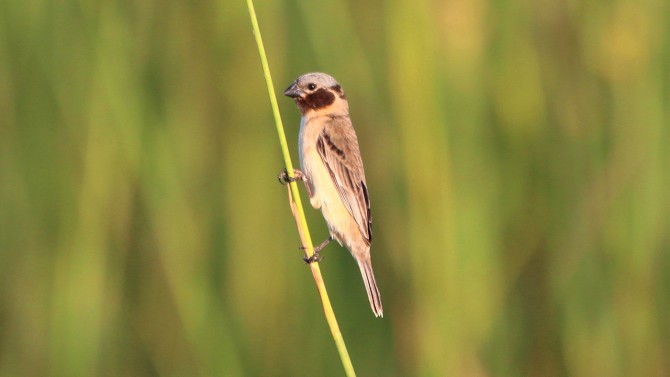New bird emerged from genetic shuffling
By Gus Axelson
Speciation – the emergence of a new species – is a slow and steady process that plays out over millions of years among a stranded group of creatures, isolated from the rest of their kind by geographical barriers and left to evolve on their own.
Or so it was generally thought.
New research published March 25 in the journal Science challenges the typical model of speciation by documenting how a recently discovered songbird in South America traveled a very rare evolutionary path.
The study delves into the origins of the Iberá seedeater in northern Argentina, which appears to have formed from a unique mixing and matching of existing genetic traits among 10 or more other species of seedeaters in the same area.
“These differing genes have been reshuffled into a unique combination that produced the Iberá seedeater,” said Leonardo Campagna, a research associate at the Cornell Lab of Ornithology and senior author of “Rapid speciation via the evolution of pre-mating isolation in the Iberá seedeater.” “This species has a mosaic of plumage genes drawn from existing genetic variation already found in other seedeater species.”
Campagna said the study shows mating behavior alone can be a powerful evolutionary force, preventing a recently diverged species from co-mingling back with others that breed in the same places, eat the same food, nest at the same time, and are nearly identical genetically. In other words, speciation doesn’t always require genetic mutations that arise in an isolated population.
And it doesn’t require millions of years. Campagna estimates that it took on the order of thousands of years for the evolutionary process to play out that birthed the Iberá seedeater as a separate species that would only mate with its own kind.
“In evolutionary terms, that’s very fast,” Campagna said. “This is the clearest example in birds of how reshuffling of genetic variation can generate a brand-new species.”
“This is a beautifully thorough and comprehensive study of the role of genes, plumage, and behavior in the origin of a new species,” said Rosemary Grant, a preeminent scientist in the field of evolutionary biology who was not involved in the study. Grant and her husband, Peter, spent decades studying the species group of Darwin’s finches on the Galapagos islands, famously discovering how natural selection influenced the shape of beaks. “This paper adds significantly to our increasing understanding of speciation.”
The Iberá seedeater is primarily found on about 274,000 acres of remote, swampy grassland in Argentina’s Iberá National Park, where study lead author Sheela Turbek, a graduate student from the University of Colorado, Boulder, spent two field seasons locating nests and performing behavioral experiments.
There, Iberá seedeater lives side-by-side with the tawny-bellied seedeater. The Iberá seedeater has a black throat and sand-colored belly, whereas the tawny-bellied seedeater has reddish cheeks, throat, breast and belly. The researchers compared the entire genomes of the two species, finding only three narrow regions that differed. These regions contain just 12 genes, three of which are involved in plumage coloration.
The study authors think the same reshuffling process found in this research probably underlies much of the diversity among the dozen seedeater species in this region of South America – mix-and-match genetic combinations that are likely generated when seedeaters occasionally interbreed and form hybrids.
“This is a really beautiful story about a process that we have never seen in quite this way before,” said co-author Irby Lovette, director of the Fuller Evolutionary Biology Program at the Cornell Lab. “The classic and most common evolutionary model for new species is the accumulation of genetic mutations when those species are separated by a geographic barrier over perhaps millions of years. But here we found that genetic shuffling can happen quickly and without geographical isolation. It’s almost like ‘instant speciation.’”
Gustave Axelson is the editorial director at the Cornell Lab of Ornithology.
Media Contact
Get Cornell news delivered right to your inbox.
Subscribe

